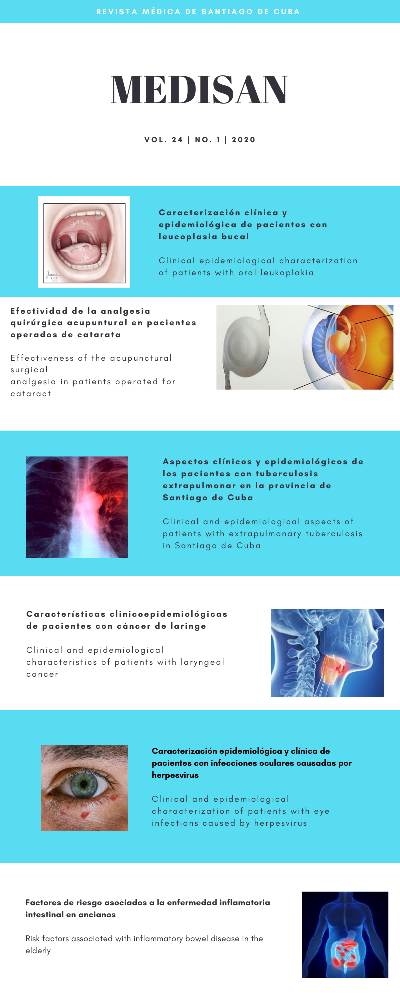Repercusión de factores socioculturales en la salud reproductiva de las mujeres de la Universidad de Guayaquil
Palabras clave:
féminas, factores socioculturales, salud sexual, salud reproductiva, planificación familiar.Resumen
Introducción: La salud sexual y reproductiva es importante para el bienestar general de las mujeres y la toma de decisiones sobre la planificación familiar; sin embargo, existen factores socioculturales que condicionan desfavorablemente los aspectos antes mencionados.
Objetivo: Determinar los factores socioculturales que condicionaron desfavorablemente la salud reproductiva de estudiantes dela Universidad de Guayaquil.
Métodos: Se realizó una investigación descriptiva y observacional de 120 estudiantes, quienes asistieron a la consulta de ginecoobstetricia dela Universidad de Guayaquil, Ecuador, durante el 2019.
Resultados: La edad de los encuestados osciló entre los 18 y 29 años (82,0 %); 55% no recibió o desconocía la existencia de los servicios de orientación sexual que se brindaban a los adolescentes de dicha universidad. Asimismo, 60,0 % de las féminas dejaron de acudir a centros de salud para prepararse sobre temas de salud sexual y reproductiva y abandonaron la protección al tener relaciones sexuales por falta de medios económicos.
Conclusiones: Los factores socioculturales influyeron significativamente en el acceso a los servicios de salud sexual y reproductiva que se brindaron a los adolescentes en la universidad con énfasis en la ausencia de medios económicos.Descargas
Citas
2. González Galbán H, Vega Briones G. Problemáticas del comportamiento sexual y reproductivo de las jóvenes inmigrantes de Baja California. Frontera norte. 2013 [citado 18/ 01/19]; 25 (50): 131-54. Disponible en: http://www.scielo.org.mx/pdf/fn/v25n50/v25n50a6.pdf
3. Ordoñez Bacter A, Suárez F. Exploración sobre los conocimientos del ácido fólico y sus beneficios en la salud reproductiva en una población universitaria colombiana. Rev Colomb Obstet Ginecol. 2006; 57 (4): 271-8.
4. Saeteros Hernández RC, Díaz Bernal Z, Sanabria Ramos G, Pérez Piñero J. Representaciones socioculturales sobre el ideal de la salud sexual y reproductiva en estudiantes universitarios ecuatorianos. Rev Cubana Salud Pública. 2015 [citado 23/01/2019]; 41 (3): 459-75. Disponible en: http://scielo.sld.cu/scielo.php?script=sci_arttext&pid=S0864-34662015000300006&lng=es
5. Ecuador. Ministerio de Salud Pública. Plan Nacional de Salud Sexual y Salud Reproductiva 2017-2021. Ecuador: Viceministerio de Gobernanza de la Salud Pública; 2017 [citado 19/03/2019]. Disponible en: https://ecuador.unfpa.org/sites/default/files/pub-pdf/PLAN%20NACIONAL%20DE%20SS%20Y%20SR%202017-2021.pdf
6. Consejo Nacional de Población. Situación de la salud sexual y reproductiva. México: Consejo Nacional de Población; 2016 [citado 19/03/2019]. Disponible en: https://www.gob.mx/cms/uploads/attachment/file/237216/Cuadernillo_SSR_RM.pdf
7. González Moreno JM. Los derechos sexuales y reproductivos como categoría jurídico internacional revisable. Rev. derecho público. 2017 [citado21/03/2019]; (38): 1-29. Disponible en: https://dialnet.unirioja.es/descarga/articulo/6331698.pdf
8. Secretaría de Salud. Planificación familiar y anticoncepción 2013-2018. Programa Sectorial de Salud. México: Secretaría de Salud; 2018[citado 20/01/2019]. Disponible en: http://cnegsr.salud.gob.mx/contenidos/descargas/PlanFam/PlanificacionFamiliaryAnticoncepcion.pdf
9. Organización Mundial de la Salud. Planificación familiar. Suiza: OMS; 2018 [citado 18/01/2020]. Disponible en: https://www.who.int/es/news-room/fact-sheets/detail/family-planning-contraception
10. Instituto Nacional de Estadística e Informática. Planificación Familiar. 2018 [citado 21/03/2019]. Disponible en: https://www.inei.gob.pe/media/MenuRecursivo/publicaciones_digitales/Est/Lib1656/pdf/cap004.pdf
11. IPPF. Salud y derechos sexuales y reproductivos: la clave para alcanzar la igualdad de género y el empoderamiento de las mujeres. London: Federación Internacional de Planificación Familiar; 2015 [citado 05/04/2019]. Disponible en: https://www.ippf.org/sites/default/files/ippf_2020_gender_2015_spa_web.pdf
12. Cleland J, Shah IH, Benova L. Una mirada fresca al nivel de necesidad insatisfecha de planificación familiar en el periodo posparto, sus causas e implicaciones programáticas. International perspectives on sexual and reproductive Health. 2015 [citado 18/01/2019]: 165-62. Disponible en: https://www.guttmacher.org/es/journals/ipsrh/2015/09/una-mirada-fresca-al-nivel-de-necesidad-insatisfecha-de-planificacion
13. Villacres Guamba LV. La asesoría de planificación familiar como factor de adherencia a métodos anticonceptivos entre mujeres adolescentes y adultas que acuden a consulta externa en el Centro de Salud Archidona (Napo -Tena) en el periodo de mayo a junio del 2016 [Tesis]. Quito: Universidad Central de Ecuador; 2016 [citado 28/03/2019]. p. 21-9. Disponible en: http://www.dspace.uce.edu.ec/bitstream/25000/11764/1/T-UCE-0006-010-2016.pdf
14. Gayet CI, Juárez F. Estimación de las necesidades no satisfechas de métodos anticonceptivos en México a través de la ENADID 2014. Realidad, Datos y Espacio. Revista Internacional de Estadística y Geografía. 2018 [citado2019 abril 5]; 9 (2): 54-65. Disponible en: https://www.gob.mx/cms/uploads/attachment/file/237216/Cuadernillo_SSR_ RM.pdf
15. Organización de las Naciones Unidas. Objetivo 3: Garantizar una vida sana y promover el bienestar para todos en todas las edades. 2017 [citado 28/03/2019]. Disponible en: http://www.un.org/sustainabledevelopment/es/health/
16. Organización Panamericana de la Salud. Estado actual de la salud de los adolescentes y jóvenes en la región de las Américas. 2018 [citado 28/03/2019]. Disponible en: https://www.paho.org/informe-salud-adolescente-2018/part-two-the-current-status-of-the-health-of-adolescents-and-youth-in-the-americas.html
17. Organización Mundial de la Salud. Infecciones de transmisión sexual. 2019 [citado 05/04/2019]. Disponible en: https://www.who.int/es/news-room/fact-sheets/detail/sexually-transmitted-infections-(stis)
Publicado
Cómo citar
Número
Sección
Licencia
Esta revista provee acceso libre e inmediato a su contenido bajo el principio de que hacer disponible gratuitamente investigación al público, apoya aún más el intercambio de conocimiento global. Esto significa que los autores/as conservarán sus derechos de autor y garantizarán a la revista el derecho de primera publicación de su obra, el cuál estará simultáneamente sujeto a la licencia internacional Creative Commons Atribución 4.0 que permite copiar y redistribuir el material en cualquier medio o formato para cualquier propósito, incluso comercialmente, además de remezclar, transformar y construir a partir del material para cualquier propósito.





